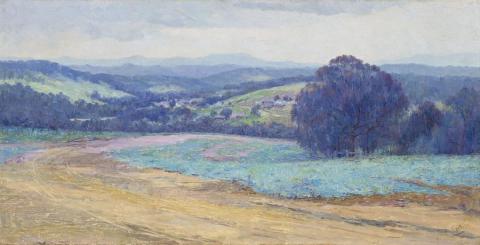THE ROAD TO WARRANDYTE, c.1905-10
CLARA SOUTHERN
oil on canvas on board
49.5 x 96.0 cm
signed lower right: Clara Southern
Retained by the artist's family
Thence by descent
Private collection, Victoria
Probably Paintings by Clara Southern, Athenaeum Hall, Melbourne, 10–20 March 1914
Clara Southern is one of the leading women artists of Australian Impressionism. During this Golden Age of Australian art, she and her colleagues Jane Sutherland and Jane Price were considered to be the three leading female figures. While Sutherland is usually given prime position, I am inclined to agree with arts writer and historian John McDonald who stated that '...one could make a credible case for Clara Southern.. as the most significant woman artist of the era.'1 Perhaps this is an honour that will be achieved when her best work, such as The Road to Warrandyte, becomes wider known. Southern studied under Madame Mouchette at the National Gallery School, and under Walter Withers at his home in Heidelberg. Her fellow students at the Gallery included Arthur Streeton, Sutherland and Emanuel Phillips Fox. Although she worked in the open air directly from the motif, and made weekend painting trips to Eaglemont artists' camp, her view of the landscape is as if seen through women's eyes. In her more lyrical approach to the Australian scene she reflected the beneficial influence of her teachers Frederick McCubbin and Withers, avoiding the heat and blinding light of the noonday sun for quieter moods of nature. Like her fellow women artists, she preferred a more domesticated bush to one populated by male heroics. Moreover, her settled countryside is often peopled with women as in An Old Bee Farm c.1900, acquired by the National Gallery of Victoria, Melbourne, through the Felton Bequest in 1942. An Old Bee Farm and other major works were included in her exhibition at the Athenaeum Hall in 1914. The exhibition confirmed that her best landscapes were painted at Warrandyte. Following her marriage to John Flinn in 1905, they moved to Blythebank at Warrandyte. She lived and painted there for the remainder of her long life. Here Southern became a central figure in a growing community of artists who at times included Louis McCubbin, Penleigh Boyd, and Harold Herbert. Clearly a leader in her time, she exhibited with the Victorian Artists' Society from 1889-1917; and was the first woman member of the Australian Art Association and first to serve on its committee. Memberships included the Lyceum Club and the Melbourne Society of Women Painters and Sculptors. Her love of the Warrandyte countryside is readily apparent in The Road to Warrandyte through its soft, magical blues and mauves, fresh greens, richness of the soil, and the gentle folds of the hills, all enveloped in an atmosphere that is palpable. It shows her close identification with the scene, passionately embraced on first sight and maintained throughout her life.
1. McDonald, J., Art of Australia, Pan Macmillan Australia Pty Limited, Sydney, 2008, vol. 1, p. 606
DAVID THOMAS
